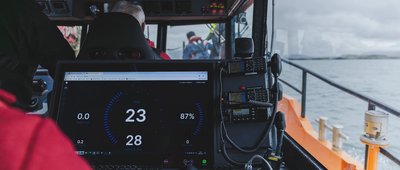Hefring Marine is on a mission to transform the maritime industry with AI technology that improves a vessel’s safety and fuel efficiency.
What started in 2018 as a research project to improve boat hulls in Iceland turned into a full-fledged mission to revolutionize how vessels are operated, monitored and maintained as the founding team identified a critical gap in the boat building and maritime safety industry.
“Real innovation comes from seeing a problem differently,” Hefring CEO and co-founder Karl Birgir Björnsson said.
In Iceland, where Hefring Marine’s story began, the company initially focused on building high-performance boats with a unique hull design that could withstand the harsh conditions of the North Atlantic. These boats were designed to reduce the impacts and shocks caused by rough waters, which can cause severe discomfort and even injury to passengers. After conducting research with the University of Iceland, Björnsson’s team realized that many boats, particularly high-speed rib boats used for tourism, caused impacts up to nine times greater for passengers seated in the front compared to the operator.
“There were news stories about passengers fracturing their spines or breaking their teeth, and we had the data to show why that was happening,” said Björnsson.
This revelation led to the creation of a simple shock monitoring device that displayed the impact data to the operator in real-time. However, the team soon realized that showing the operator what had already happened wasn’t enough—predicting the shocks before they occurred was key. This prompted the development of an advanced algorithm capable of forecasting wave impacts ahead of the vessel, making operations safer and more efficient.
Hefring’s innovation lies in its ability to transform raw data into predictive insights. Hefring’s system connects directly with the boat’s navigation, engine and motion data, providing operators with a comprehensive understanding of how their vessel is performing and predicting conditions in real-time. This level of integration and predictive capability is something entirely new in the maritime industry.
Momentum and Looking Ahead
The company’s traction is clear. Hefring has nearly tripled its user base and seen a five-fold increase in sales year-over-year. With a growing customer base in the commercial and defense sectors, the company is poised for rapid expansion. By the end of the year, Hefring aims to establish a dominant presence in the recreational leisure market and reach $2-2.5 million in annual recurring revenue.
Hefring Marine’s goal is to become the leader in maritime data intelligence. The company plans to further enhance its predictive capabilities, expand its global footprint and continue improving the safety and efficiency of maritime operations.
Scaling Across Many Sectors
As Hefring Marine grew, it began to attract attention from a wide range of maritime operators, including large nationwide fleets, government agencies and search and rescue teams.
“We’re seeing our product being used in various sectors, from defense to commercial fleets to recreational vessels,” Björnsson said.
Hefring’s predictive system not only enhances safety but also helps companies optimize fuel usage, reduce CO2 emissions and maintain vessels more efficiently.
One of the company’s key partnerships has been with TechNexus Venture Collaborative, which participated in Hefring’s recent round of financing. By connecting Hefring with a broader network of investors and partners, TechNexus is helping the company accelerate its growth and expand its reach. This partnership is also a testament to Hefring's innovative approach and commitment to modernizing a traditional industry.
“The maritime industry is long overdue for modernization,” Björnsson said. “We believe data and intelligence will be the driving forces of that change.”
